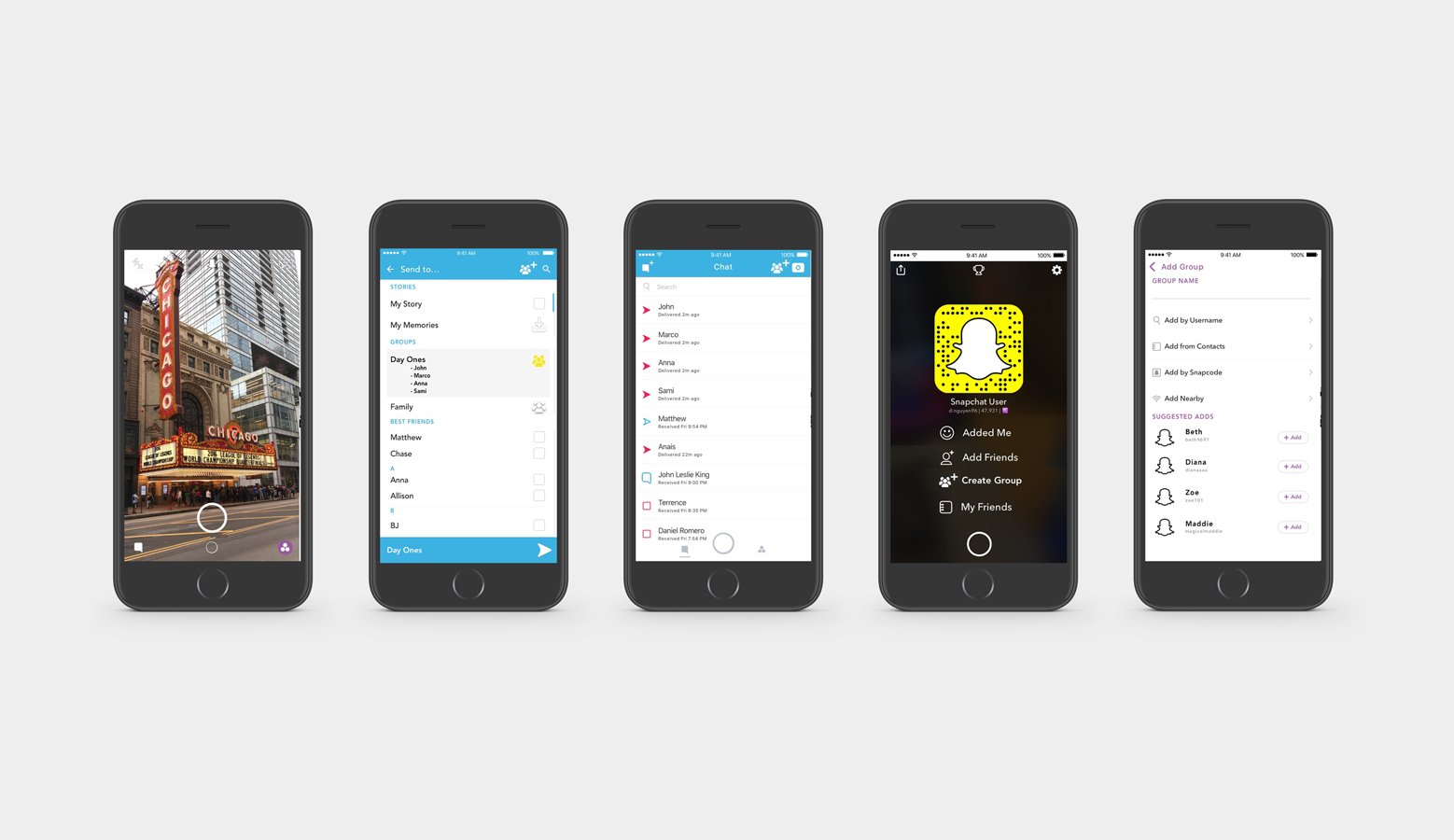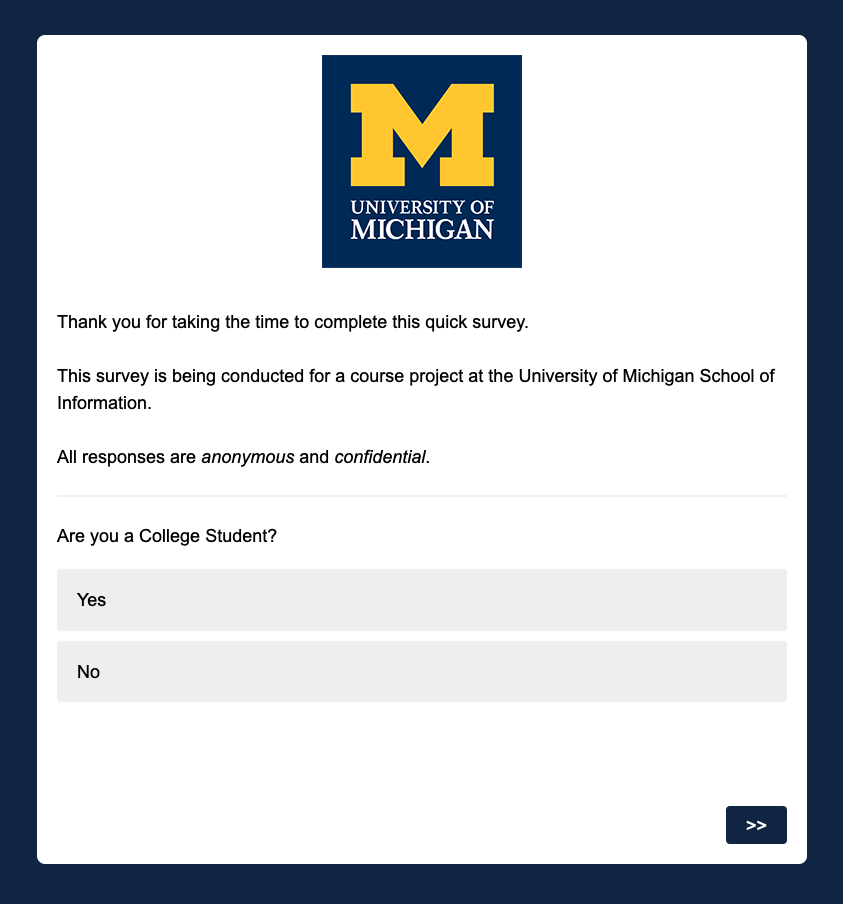Snapchat Research
Assessing privacy, security, and user needs.
Project Type
User Research
My Role
UX Researcher, Editor of Reports
Course
SI 422: Needs Assessment & Usability Evaluation
Tools
Qualtrics, Sketch
Team Credits
Terrence Green, David Nguyen, Maddie Purcell, Anais Schricke, Molly Warden
Date conducted: 2016
The Problem
Snapchat has limited privacy settings and is not very transparent about the security of its app, such as what happens to photos once they disappear from view.
Target Users
College students
Project Goal
Through user research, we wanted to learn how users feel about privacy and security of Snapchat, how these feelings compare to privacy and security thoughts of other social media, and how Snapchat can best improve the user experience of their app to meet user needs.
Challenges
As students conducting research for a class, we were unable to access corporate information about how Snapchat app is built and what actually happens to photos after they disappear from view. Our information was limited to what had been revealed in the media up until the point when we conducted this project.
Key Takeaways
Through this project, I learned how to design and conduct a variety of user research methods.
I gained experience testing a new feature idea for an existing app and interpreting research data results.
The Process
Interviews, Personas, & Scenarios
Gained better understanding of Snapchat's user base and use cases
A/B Testing
Presented users with a new group feature and asked users how it compared to current version of Snapchat
Usability Test
Asked users to perform a variety of tasks on Snapchat & evaluated them based on time and accuracy
Survey
Asked questions that measured attitudes, behaviors, and characteristics of our users
Interviews, Personas, & Scenarios
We began our research with interviewing other college students to get a general idea of how they feel about Snapchat and how they use it. Each member of our group sought out two individuals to interview with a separation factor of two, meaning we knew of them through friends, but did not know them well enough to result in a biased interview. We also coordinated with each other to make sure we were interviewing people who would represent the diverse demographics of college students, and were able to achieve an interview pool of students of different grade levels, majors, and ethnicities. We came up with the following research questions and interview script, which we each followed when conducting our interviews.
Guiding Research Questions
How do typical college students use Snapchat?
How does use of Snapchat compare to use of other social media sites?
Why does usage of Snapchat differ from usage of other social media sites?
How do users feel about privacy and security when using Snapchat?
How can Snapchat improve their platform?
Interview Script
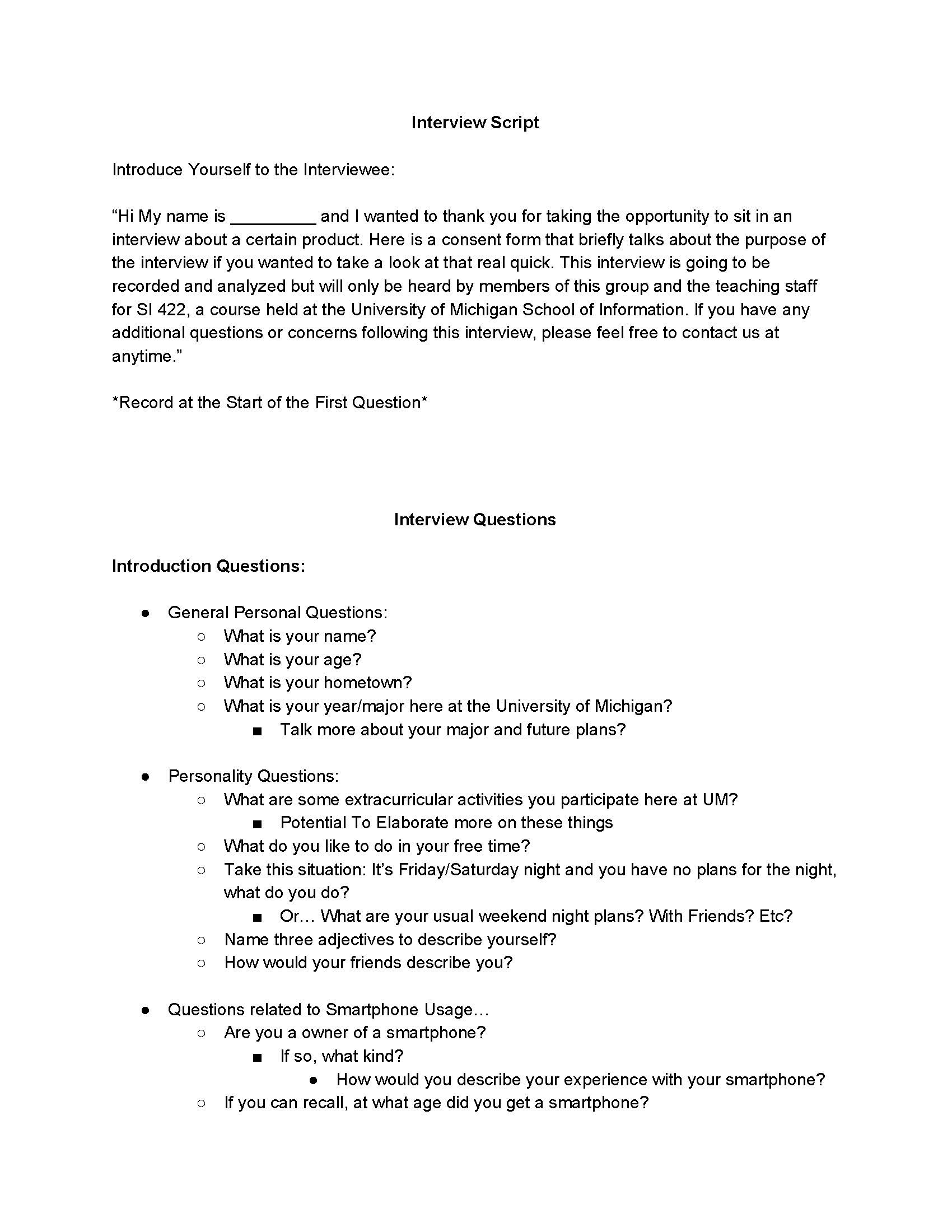
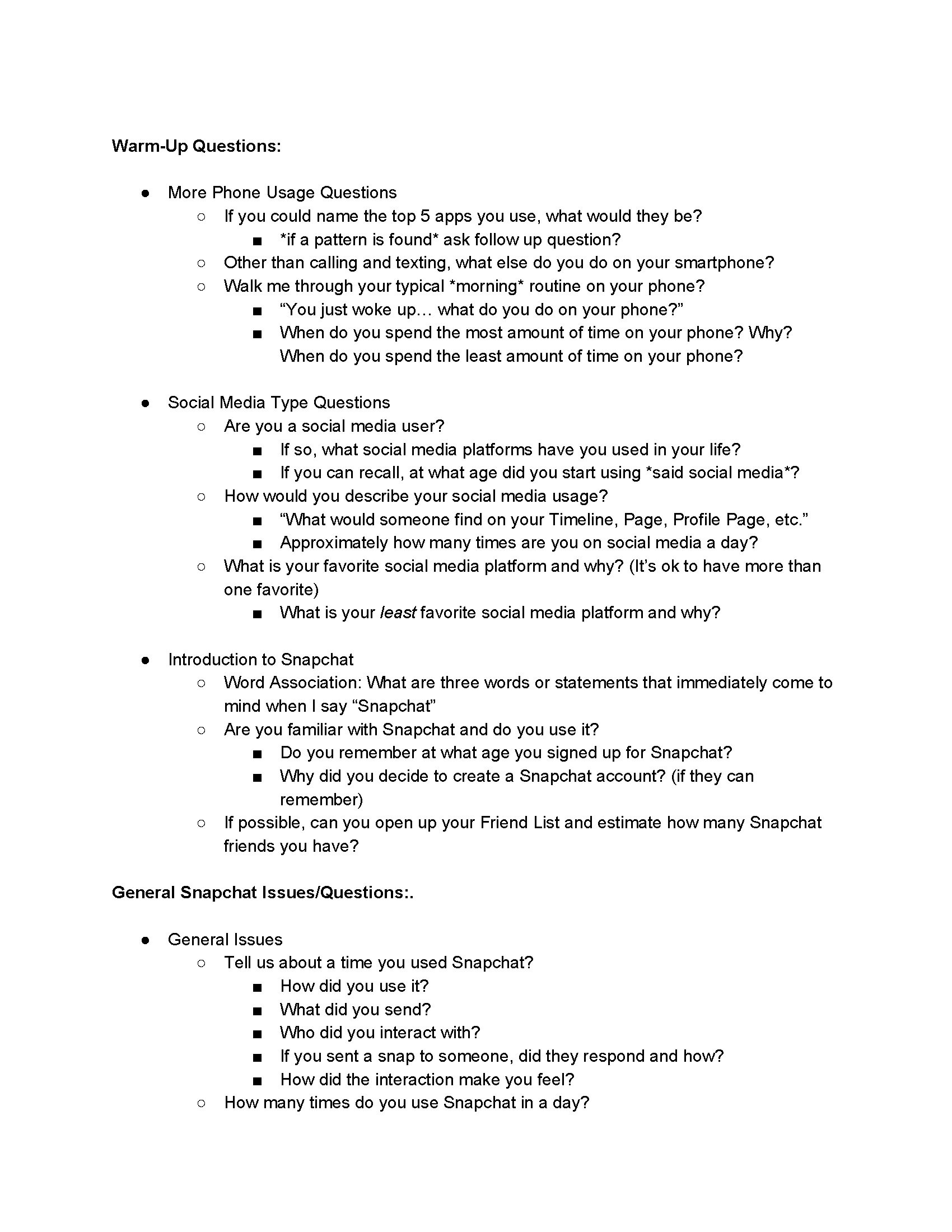
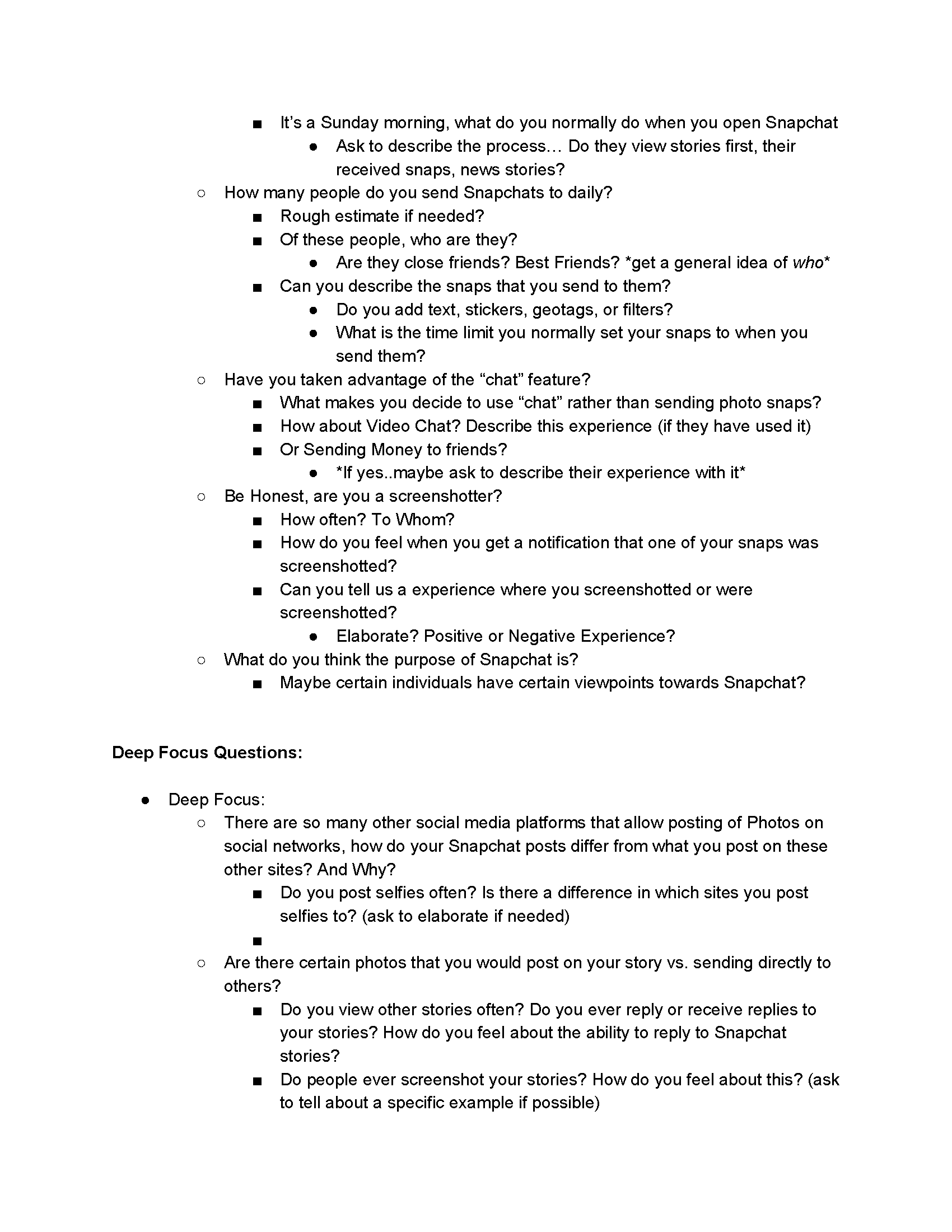
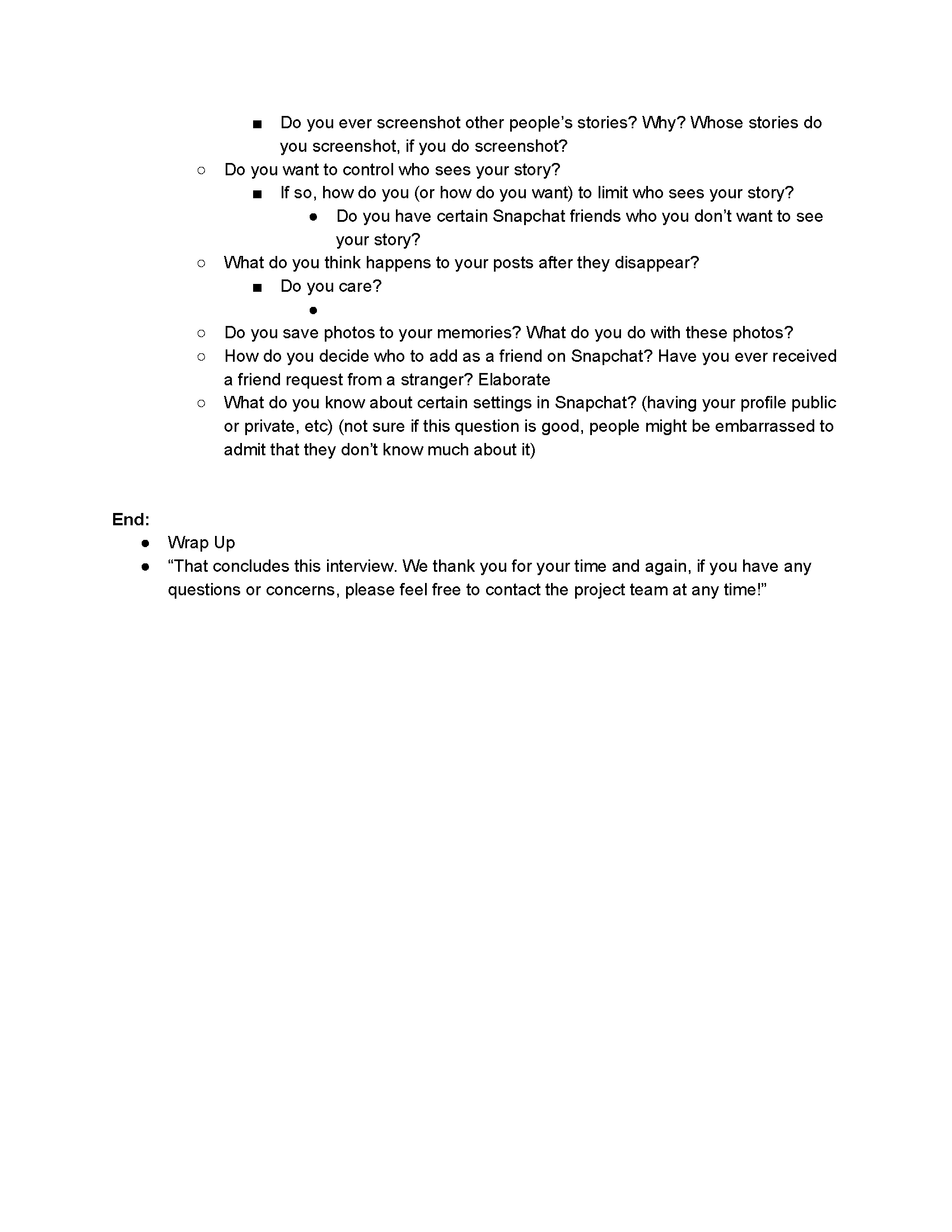
Coding Interviews
After holding the interviews, we each listened to the recordings and coded them according to the key we created, which highlighted the main themes we encountered.
Key
Findings
Most interviewees primarily use Snapchat to interact with their friends.
They see Snapchat as more “spontaneous” and “genuine” than other social media sites, and it allows them to see what is happening in their friends’ lives in “real time.”
A few said they see Snapchat as an easy way of "mass communication" and to find out about events that are happening.
Many either did not know they could limit who sees their story or said they wouldn’t bother ever taking the time to go into the settings and specifically limiting who sees it.
Some were very surprised and concerned when asked about what they thought happened to their snaps after they disappear. Others were not concerned as they don't send "anything bad" on Snachat. Generally, the consensus was that many people do not know much about their privacy and security settings on Snapchat, but the benefits and enjoyment they feel from using Snapchat outweighs the risks, and thus, they keep using Snapchat.
Example of a coded interview
Personas and Scenarios
After analyzing our interviews and concluding our findings, we created three personas and scenarios to sum up three different users and their individual use cases of Snapchat.

Persona 1: Hannah, New User

Persona 2: Justin, Concerned about cybersecurity

Persona 3: Katie, Worried about screenshotting
A/B Testing
To provide users with a more secure and satisfactory experience with Snapchat, we decided to tackle the issues of user control and ease of use. We prototyped a new group feature for the app, allowing users to create groups of friends within their friend lists. We thought users might choose to send certain snaps or stories to specific subgroups, like family members or friends who belong to specific clubs or social groups. Allowing users to send photos to a preexisting group eliminates the need to scroll through their friend lists to determine their intended audience, which reduces the probability of accidentally hitting the wrong name or excluding someone that a user might have wanted to send a photo. Many of the users that we interviewed were not aware that they currently have the ability to block certain people from viewing their stories. They merely accepted the fact that some of their Snapchat stories would be seen by a few people that they did not want to see them. Our proposed group feature would help users feel that they have complete control over who sees the photos that they send, every single time.
In order to test the idea of a new group feature, we came up with the following hypotheses and constructed a within A/B test in which our users are presented first with the experiment designs with the group features and then the control designs with the current Snapchat interface. We posted our survey on social media and received 103 responses, which we then analyzed.
Hypotheses
Users feel that the new group feature makes it:
Easier to share photos with select groups of people rather than individuals or everyone.
More efficient to share photos with select groups of people rather than individuals or everyone.
Users will opt to use the group feature over the Story feature when they would like more control over the intended audience.
A - Experiment
B - Control
The Survey
Findings
Our results showed us that people like Snapchat both with or without the group feature. While there were more users who were “Extremely satisfied” with the interface that included the group feature (47 participants, as opposed to 22 for the current Snapchat interface), 73 users were either moderately or extremely satisfied with the current Snapchat interface and 84 people were either moderately or extremely satisfied with the Snapchat interface that includes the new group feature.
We then ran three paired t-tests to determine whether there was a significant difference in:
Satisfaction of both versions
Fear level in regards to receiving unintended viewers
Time needed to send snaps between the two options
Looking at our paired t-tests above, there is indeed significance for both satisfaction and time to send a picture to seven people since the p-value is less than 0.05, our level of significance. This confirms Part 1 and Part 2 of Hypothesis 1; Users feel that the new group feature makes it easier to share photos with select groups of people rather than individuals or everyone, and users feel that the new group feature makes it more efficient to share photos with select groups of people rather than individuals or everyone.
We found no significant different for our measure of whether or not someone is worried about unintended viewers, and thus, we cannot confirm Hypothesis 2.
Our results showed that the group feature is not imperative to Snapchat users because most of our participants do not seem very worried about receiving unintended viewers. However, we think that people would like it and use it. We received positive feedback from almost all participants and think that given a larger sample, Snapchat would see enough evidence to move forward with the idea and implement it.
Usability Test
Over the course of the semester, we shifted our focus from exclusively looking at ways to improve privacy and security to looking at how users use existing features in regards to their privacy and security, as well as looking at ways to improve the user experience in general. With our usability tests, we looked at which existing features of the application typical college Snapchat users are aware of and use. Following the research questions below, we constructed a script that asked our test subjects to perform various tasks on Snapchat using a test account that we created. We tested 5 college students, and each time, we had an interviewer read off the script and instruct the user, another team member who acted as the data logger and recorded the participants actions and comments, and a third who was the observer and took notes during the test.
Research Questions
How do typical college students use Snapchat?
How much do users know about existing Snapchat features that can enhance their privacy?
What features of Snapchat are users unfamiliar with? Where is there room for improvement?
Usability Test Script
Logging Form Template
User Time Logs
Findings
All of our participants were able to complete at least 8 out of 12 of the tasks. For the remaining four tasks, User 3 was the only participant who was unable to complete 3 of the tasks while the rest of the participants were successful. For the other counted task of sending a friend $1, User 5 was the only one who was successful. With regards to our research questions, we found that:
Users who are familiar with the application are very comfortable sending direct snapchats, posting stories, and adding friends.
Users are not well informed about existing features on Snapchat that can enhance user privacy. For example, our test participants had a difficult time deciphering the difference between blocking a user from viewing their story and blocking a user completely, suggesting they did not know that both options exist. Our participants showed that they were able to block another user on Snapchat, but 2 of our participants could not find the option to block a Snapchat friend from viewing only their story and not block them entirely.
Reflection
Looking back on the design of our tests, we could have improved them by:
Being more specific with our task requests.
For example, instead of saying “block the ‘UOfMichigan’ account you just added from viewing your story, but still allow your other friends to view it,” we could add “but don’t block them from Snapchat entirely.”
Changing the ordering of the questions.
If we asked our participants to block an account entirely from their Snapchat and then asked them to block a different user from viewing only their story and not the rest of their individual snaps, participants would have better understood what we were specifically asking them to do. Before the usability test, we did not foresee that participants would block an account entirely when asked to block an account from seeing their story. By switching up the order of the questions, we would avoid this possibility.
Adding more interaction directions such as asking them to send a photo of themselves to 20 people and then asked them to send a similar snap to their story. This would have allowed us to time how long it takes them to complete each task and see which one is faster.
Survey
To conclude our research, we created a survey obtain more in-depth data directly from users. We created it on Qualtrics and distributed it to 28 people. The survey consists of 38 questions. When creating questions, we used our original research questions as our guide and made sure our questions measured attitudes, behaviors, and characteristics of our users. Our questions focused on figuring out how users feel about Snapchat in general and how they use the app versus its competitors. We also included characteristic demographic questions to help us make sure the respondents we sampled fit into our target user base.
Survey Findings
Users gave Snapchat an average satisfaction level of 82.37 / 100
Users report they are most likely to post Selfies on Snapchat than on any other social media.
Users are more willing to post silly or lesser-quality photos on Snapchat because of its temporary nature.
People use Snapchat more as a means of communication with friends than as a way to broadcast oneself to followers.
Users send an average of 18 snaps per day to around 1-10 people
Most users do not send snaps to their stories every day
Snapchat could work on providing new ways for users to better control who sees their snaps, such as adding a group feature.
Only 25% of our respondents have blocked somebody from viewing their story
96% reported having sent a snap to the wrong person
Snapchat Version 9.45.0.0
While we were writing our final report for class, Snapchat released an update allowing users to create groups with up to 16 people, very similar to the idea we had come up with.

